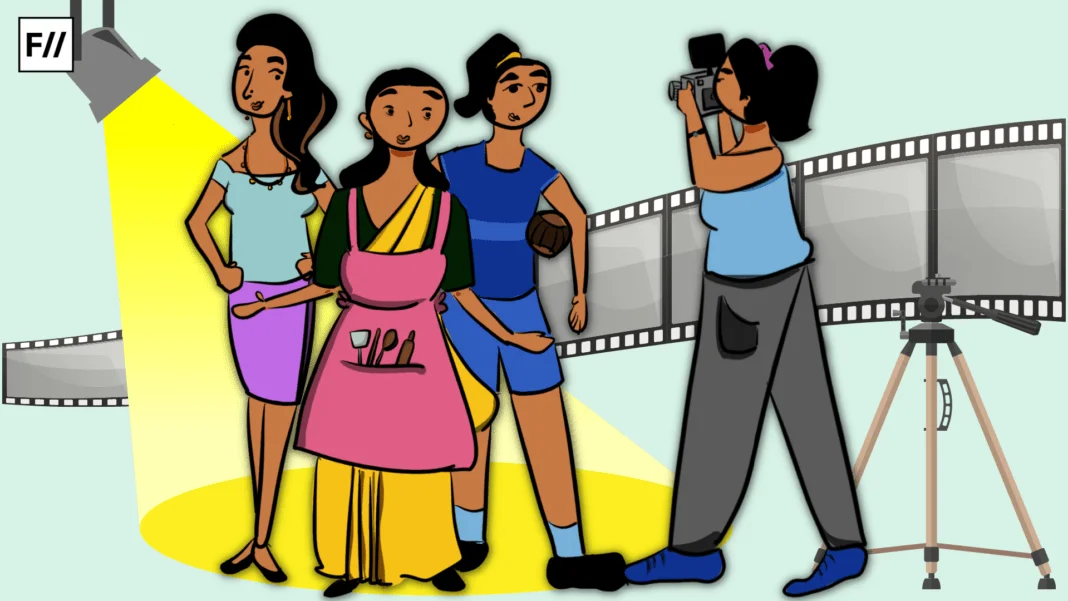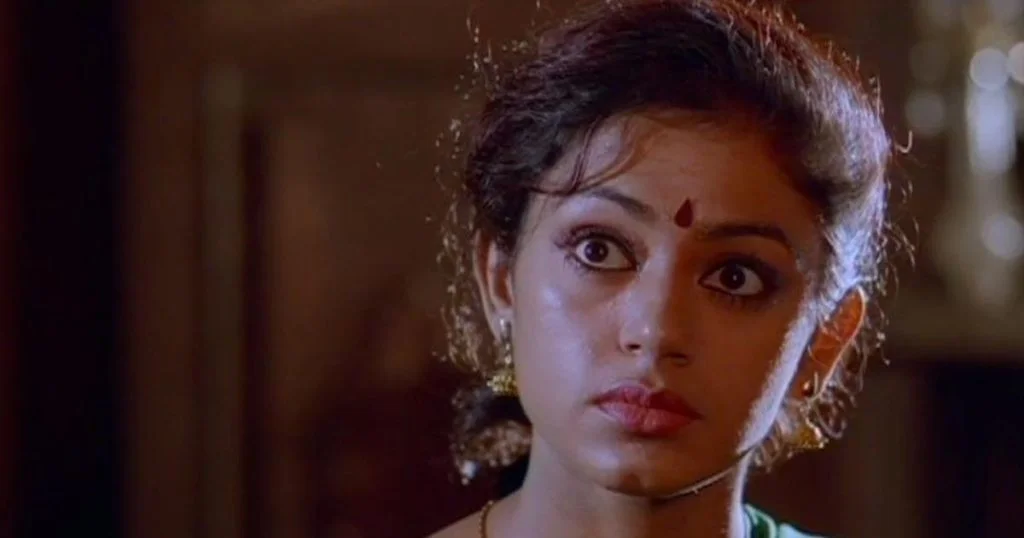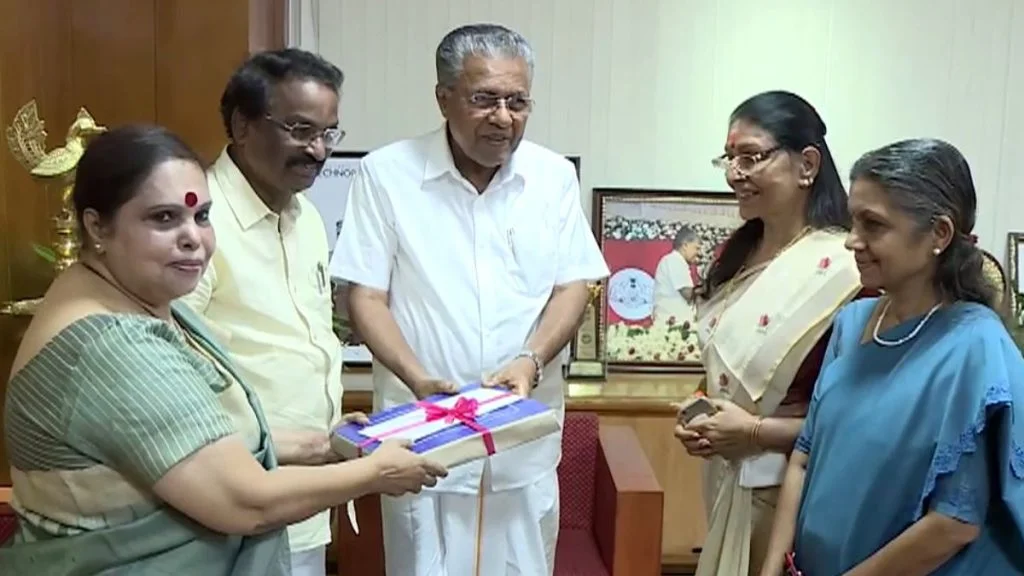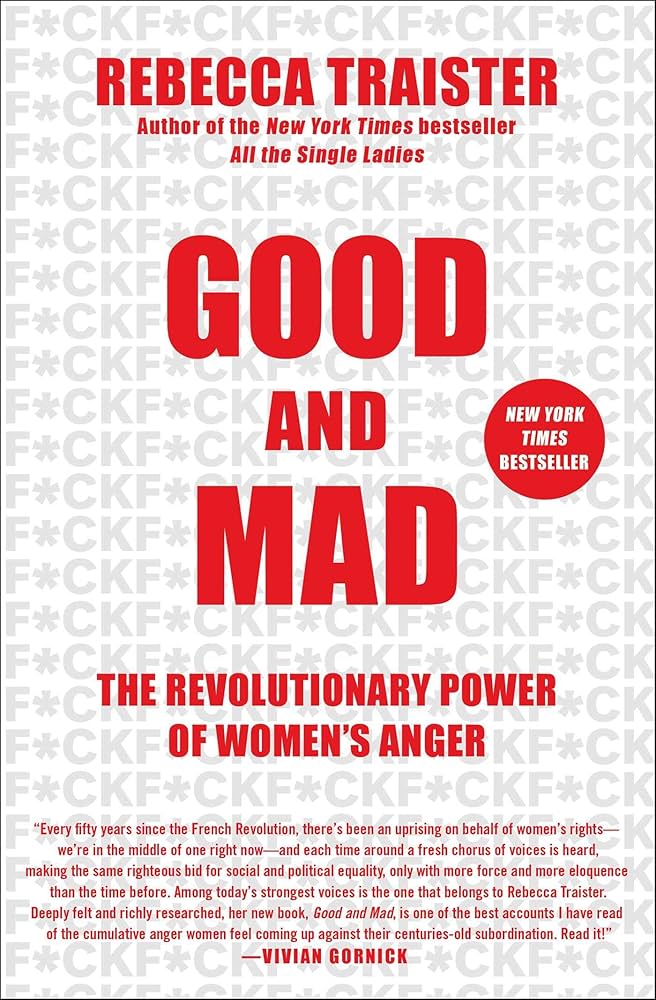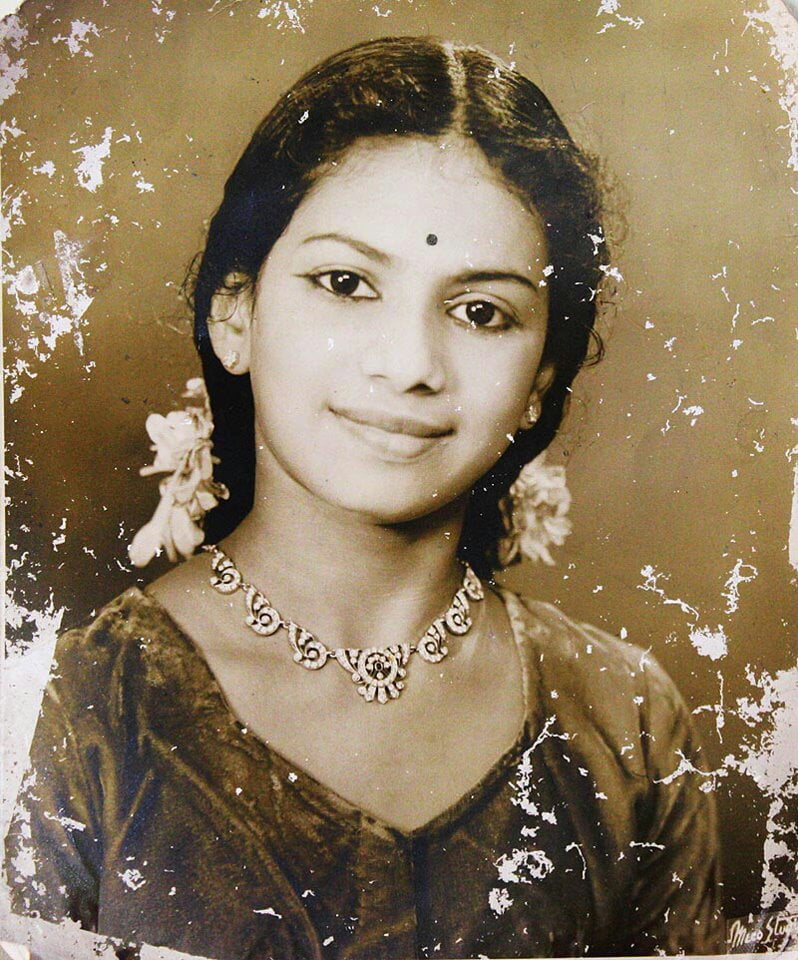Fazil’s Manichitrathazhu (1993) is making waves again like always upon its 4k enhanced rerelease on Aug 17. This film was a joint effort of multiple directors. While the film is getting celebrated more with time, the cult status of the film seems to only grow with different readings that have developed over time. The film franchise is now celebrating its sequels and prequels in Bollywood, Tamil, and Telugu, but the story of the main mythical character of Nagavalli still creates an enigma that is constantly evolving with time in the Malayali public sphere. This enigma could be a probable reason why the Malayali audience doesn’t seem keen on a franchise of the same but retain it as a celebrated classic.
In Manichitrathazhu, the figure Nagavalli is a ghost of a dancer scorned by patriarchy.
While the popular plot of the film now gets discussed as the marital and sexual dissatisfaction between the lead couple and how the heroine seeks solace in the chasms of her husband’s ancestral home that had multiple rooms locked with ornate locks, waiting to unleash phantoms and angels that danced to the tunes of yearning.
In Manichitrathazhu, the figure Nagavalli is a ghost of a dancer scorned by patriarchy. Her anger is justifiable as she is confronting her murderer from behind her door locked by him. These provocations make her lash out and this pattern to lash-out can be safely termed as the Nagavalli syndrome; a phrase to indicate the heights of female wrath when there is no other option.
Within Malayalam cinema audiences, the character of Nagavalli has become a cultural archetype for uncontrollably outrageous and stubborn women; also, often intended as a title/attitude/slur to disregard the angry, bossy/controlling, extra-opinionated, and complaining women. These names against women are not uncommon still, but their origins seem to arise from female cultures of perseverance and resilience than the manly fervour to attain incremental decrees of power and challenges as far as structural contexts work.
Actor Indrans caricatured a Nagavalli in the film Thumboli Kadappuram (1995) as an eccentric probably suffering the Nagavalli Syndrome in retrospect. We also saw Nazriya becoming Nagavalli with her father for less than a minute as Pooja in Ohm Shanthi Oshaana (2014) while having a disagreement. While both these films tried to use Nagavalli’s anger for comic relief; the culture of ridiculing female anger and rage, at the professional and personal levels, could be seen as one among the triggering points for the formation of the historical Women in Cinema Collective (WCC) and their submission of the Hema Commission Report (HCR) in December 2019 which got released on 19 Aug, as the nation continues to lament the murder of the 31 year old female doctor from Kolkata who was also brutally raped while on duty.
The Hema Commission report
The HCR submitted on December 31, 2019, had not been released by Kerala government until the recent order by the Kerala State Information Commission (SIC) to make the report public by July 25, 2024. The new report will have to ensure that sensitive information and ‘influential names’ be redacted to protect ‘their privacy,’ despite having many accounts that classify for criminal cases not just under harassment, but also rape and assault.
The last person to challenge the release of the protracted and legally wrangled document’s partial release, was actress Ranjini. This was dismissed by the Kerala HC citing that her plea was not admissible due to technical reasons. Out of the document, pages 72-80 and 81-100 are the redacted parts consisting of the deposed cases of sexual harassment that reports perpetrators as mostly people who are not officially or consistently part of the industry. There are auditions attended and conducted for these adjustments and compromises out of the promise to land work. These are the pressing concerns going viral as listicles and stories.
Upon the release of the report, we got to know about the midnight knocks on hotel room doors that is again uncomfortably similar to many rape scenes from Indian cinema in general. Reporter Nidhi Suresh’s recent long form from TNM, details about her own experiences of undergoing harassing and uninviting actions from popular male foot soldiers sustained by superstar mafias.
Reporter Nidhi Suresh’s recent long form from TNM, details about her own experiences of undergoing harassing and uninviting actions from popular male foot soldiers sustained by superstar mafias.
Bina Paul, Editor and one among the vanguards of WCC stated at the TNM debate with Dhanya Rajendran; – ‘WCC is not a witchcraft! This report is not to destroy the industry, but to build the industry. Everyone’s talking about the new waves of Malayalam cinema, but don’t forget that systemic problems of gendered nature are still prevalent. The bottom-line is to address invisibilisation and claim dignity of labour, so Malayalam cinema can pave the path for addressing safety and inclusive workspaces for everyone and not only women.’
Fellow WCC member and actor, Reema Kallingal adds to the TNM debate; – ‘In our Malayalam industry, ‘people used to live in the production sets.’ Hence the power of claiming effective ownership and functioning of these work units continues to be heavily skewed while making decisions concerning gendered dynamics in general.‘
Hence, many involved with WCC failed to land work in Malayalam and this included even actors who spoke against the proliferating cultures of superstardom. Same problems and patterns continue in other industries, depending on the caste and class differences based on regional and cultural. Ex-RJ Suchitra’s statements about Tollywood mafias and their dark wars were shocking, yet the tendency of civil and mostly elite societies is to see her ways of addressing her issues in public, in an emotionally unhinged manner, didn’t seem very acceptable especially for elite audiences and continued the rumoured accusations about her mental health that was made public by her ex-husband, Kartik Kumar during the suchi-leaks row, which is another example of looking at an outsider woman who was probably silenced and pranked, now roaring back at her perpetrators.
This again seems similar to the tendency of trivialising her rage due to her language, which leaves her with the limit of resorting to Nagavalli syndrome – to make herself seen, heard, and considered.
Female anger: a trope of Malayali comedy film and society
Casual acts of negligent sexism, body shaming and demeaning one another or a vulnerable community, are not accepted as comedy anymore especially in online spaces, but television channels continue certain trends from the previous eras. Problematic dialogues and actions are being roasted online daily and there is no easy way of forgetting or forgiving these foresights anymore.
Problematic dialogues and actions are being roasted online daily and there is no easy way of forgetting or forgiving these foresights anymore.
The box office failures garnered by actor Dileep post the assaulting of a fellow female actor is a testament of changing attitudes towards outdated mindsets. There is no liberty to have an anti-feminist or an anti-queer position like assuming an ableist or heteronormative society anymore.
Rebecca Traister in her 2018 book Good and Mad: The Revolutionary Power of Women’s Anger states— ‘It’s harder for women to traffic in anger without being punished, because … we’re told from birth that anger makes us unlikable and unserious.’ Women in public collectives and engagements are generally dissuaded by men and women, starting at the familial and gradually progressing to the institutional and societal levels.
While the kind mother is compassionate and sweeter to her sons, she is a sour puss with her daughter to slut and body shame her. Young and good-looking female teachers usually invite scorn from their students for not being compassionate or fun enough. Whereas assertive and brooding male professors in their middle-age is still a perverse turn-on, subtly substantiating Plath’s problematic line— ‘Every woman adores a fascist.’ One might wonder if she wrote this because women were left with no choice but to adore that brute heart of a brutal fascist her father was to her.
Assertive anger is attractive as it is an accepted form of emotional expression that reciprocates considerate engagements and respectability in mature ways if the root of our anger is practically weighed and considered. When we have showstoppers like Arnab Goswami and Rahul Easwaran heading news discussion channels as flagbearers of “manly debates;” shouting and throwing fits, profane language, and threatening punchlines, delude the reality and fiction of their virtual worlds and leaving the study of masculinity hazy.
When a woman has power at her disposal, she is often expected to be a social organiser.
Traister also claims, ‘Independent women living outside of marriage threaten all kinds of things about the way power is supposed to work.’ This tendency to control female agencies when they behave in ways out of the family and feminine, garners extra anxiety in the public and institutional context. When a woman has power at her disposal, she is often expected to be a social organiser.
Fearing independent women or the female rage?
Actor Madhavi’s portrayal of the metaphoric title character Gandhari (1993) is where we see the transformation of a girl from an earnest student, lover, and friend, into an underworld lady don. It’s in the second half of the film that we see the girl becoming a fashionable and ferociously rich lady, like Rekha in Khoon Bhari Maang (1988), befriending underprivileged goons and a tabloid press reporter at her control. This theme of transforming women into the powerful-social-organisers or vengeful and unstable, were common tropes of Indian cinema starting from the 60’s with films like Kuttikkuppayam (1964) and Chemmeen (1965).
Malayalam cinema did not explicitly try to draw a straight line of distinction between a caricatured modern-woman/society-lady (as known in Kerala thanks to the timeless performances of the veteran actor Sukumari) to a self-avowed feminist position that we can see in more films starting with the late 70s.
The genealogical lines drawn from the female “social organiser” persona/consciousness in left-modernist films of an earlier phase, like in Kallichelamma (1969), and the early Manju Warrier characters embodying a “cultured individualism,” like in Kannezhuthi Pottumthottu (1999), suggests one among the evolutions of the ‘feminichi‘ that we are aware of today. Oru Penninte Katha (1971), Chattakaari (1974), and Avalude Raavukal (1978) are other films where modernist female aspirations are “punished” or rehabilitated.
Actor Sukumari as a modern aunty used to get suitably punished by the narratives of her films like Priyadarshan’s debut film Poochakku Oru Mookutthi (1984), Amma Ammayiamma (1998), Kaliyil Alpam Karyam (1984) and Gandhinagar Second Street (1986), to name few examples.
We see deviant female characters repenting and returning to the glory of their homes, family, and lover in popular narratives. Whether it be the Virgin Mary or Mary of Magdalene. The social-organiser roles of female characters reconcile normative narratives as they are in no position to complement a lifestyle that supports independence or rage. In the recent female-centric masterpiece Ullozhuku, the audience gets left with a surprising focus in the end, where both the female leads decide to live with each other, along with undercurrents of their interior and exterior worlds.
The term hysteria was used as a clinical term to describe an illness that women suffered every month. Female anger is often reduced into a spectacle like how the famous Malayali Satirist and writer—V.K. N, translated the term- ‘feminist,’ quite brutally and entitled in his chauvinistic vigour as orumpatoval—roughly translatable as an eccentric woman, on the loose. Such women are often attributed as troublesome, fallen from grace, mad/eccentric, interfering, intimidating/overbearing, heavy-handed, imposing, etc. Her assertiveness is a battle she has to earn after multiple attempts of proving herself.
Rage as a conduit for change in films and off screen
Historical figures like Nangeli and Kuriyedathu Thathri/Savithri reformed womanhood for their communities of women in Kerala. This also makes the angry woman an ideal queer diva of our times, where the angry-young-and-old-woman is not always hot-headed, but clever and opportunistic. J. Devika states in her recent work—Feeling Kerala, about the Angry young woman as- ‘Women’s labour force and work participation rates in Kerala have been generally abysmal…at this point, the strong individuation of the young Malayali woman meets her undervaluation in the family and the labour market, thus the angry young woman is born. Conservatives may think that this anger is fanned by the leftists and feminists. But this anger is structural—it comes in fundamental, political, socio-economic, and cultural shifts. It can present itself as liberating public anger; it can also be repressed and perverted.’
Fearing the scorned woman is an ancient allusion credited to William Congreve. There have been sustainable means to engage with intense emotions. To forgive and heal from the aftermath of pain, grudge, and resentment, takes time and its best to walk-away when the same becomes a repetitive pattern. We must find ways to take ourselves less seriously, be better listeners with compassion, and laugh together at ourselves, but beware of our implicit biases when we choose to follow gendered practices, differences, and ideologies.
